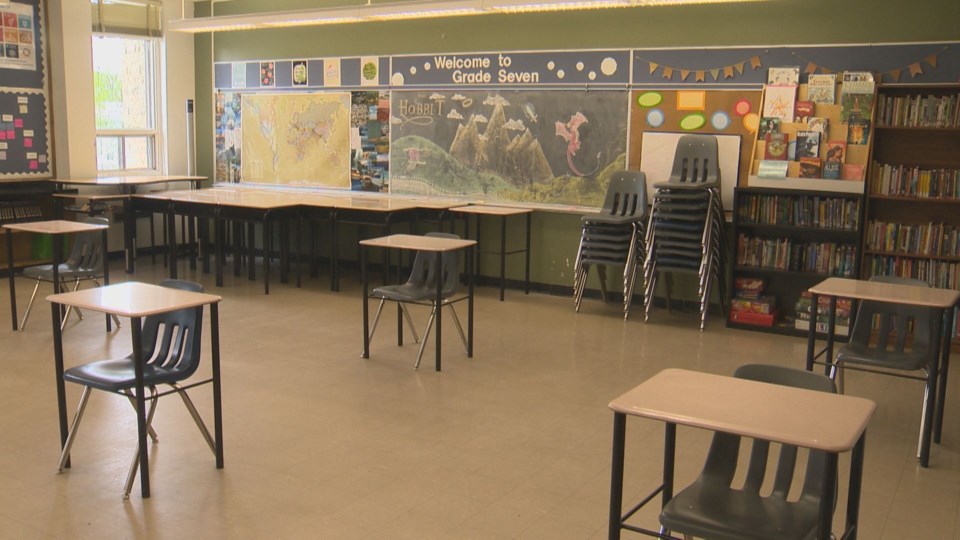As children and teens prepare to head back to elementary and secondary school classrooms in September, the Algoma District School Board (ADSB) and Huron-Superior Catholic District School Board (H-SCDSB) are aiming to make sure social distancing is put in place at schools due to COVID-19 concerns.
“We will be advising our schools to place desks in such a way that they are as far apart as possible from each other and all facing in the same direction (e.g., the front of the room), to minimize risk,” wrote Rose Burton Spohn, H-SCDSB director of education, in an email.
Larger classes of students may be relocated from a classroom to a larger venue, such as the school library or amphitheatre, she wrote.
Also in the interest of social distancing, elementary students will be learning, eating, playing, and socializing within one cohort (or group) for the full day, including lunch and recess, and student-to-student contacts will be limited to 50 students at the elementary level.
Recess and lunch times will be staggered in many schools to allow students to use the schoolyard more safely during unstructured time, Burton Spohn wrote.
Secondary school students will be cohorted (grouped) for the full day and student-to-student contacts will be limited to 100 students.
Due to that limited contact, high school programming will be quadmestered, meaning students will take two courses from September until mid-November (instead of the usual four), then the other two courses from mid-November until the end of January.
Each course will run for 150 minutes, separated by lunch (which will be eaten in a classroom).
All students from Grades 4 to 12 will be required to wear a mask while at school, as announced by the provincial government last week. Students in Kindergarten to Grade 3 will be encouraged to wear masks as well.
The Ministry of Education has announced it will be providing up to $30 million in new funding in 2020-2021 to support the hiring of additional teachers, where needed, “to support pressures related to supervision, keeping class sizes to funded averages, remote learning and other safety related measures.”
Funding will be on an application basis, school boards required to show they have managed classes as close to the funded average class size as possible and used reserves of up to one per cent of their operating budgets.
The ministry will also provide $50 million in new funding in 2020-2021 to support the hiring of additional custodial staff (to keep schools thoroughly disinfected during the pandemic).
H-SCDSB currently employs 350 permanent teachers and 110 occasional teachers, some of whom could be offered a long-term occasional position for the next school year.
“We do not yet have a sense of how many occasional teachers will be offered such positions but anticipate knowing more within the next two to three weeks,” Burton Spohn wrote.
“H-SCDSB currently employs approximately 55 permanent caretakers, some of whom work part time and some of whom work full time. In addition, we employ approximately 45 casual caretakers across our system. We anticipate that some of these casual caretakers will be offered additional hours during the 2020-2021 school year, so that high-touch surfaces in our schools can be cleaned with more regularity,” she wrote.
Frank Palumbo, the ADSB’s superintendent of human resources, told SooToday there are currently 407 elementary teachers, 270 secondary teachers and 133 custodians within the board.
“We are not sure of the numbers we are hiring at this time,” stated Fran Walsh, ADSB communications officer.
Meanwhile, the ADSB is asking parents of elementary and secondary level students to fill out an online survey by the end of the day on Wednesday, Aug. 12.
The survey gives ADSB parents a look at safety measures that will be in place and then asks important questions to which the board needs answers, enabling the board to better prepare for September and for the possibility of a school closure, if necessary.
At least one Ontario teachers union is dissatisfied with the government’s back to school plan.
“The government has ignored medical advice on the need for smaller classes of 15 students, and provided only enough funding ($30 million) to maintain class size averages of 24.5 students in grades 4-8,” stated Sam Hammond, Elementary Teachers Federation of Ontario (ETFO) president, in a release issued Friday.
“With the current plan, students will be returning to crowded classrooms without the possibility for the physical distancing that parents, education stakeholders and public health advocates have been asking for,” Hammond said.
“While Minister (Stephen) Lecce said today that school boards can reduce class sizes by spending from their reserves, not every board has the reserves to do that. The government knows that class size is a problem, but refuses to make the necessary investment to ensure that every child in the province is safe,” Hammond added.
ETFO says the government’s plan has ignored The Hospital for Sick Children report, COVID-19: Guidance for School Reopening, which called for smaller class sizes to maintain better physical distancing.



